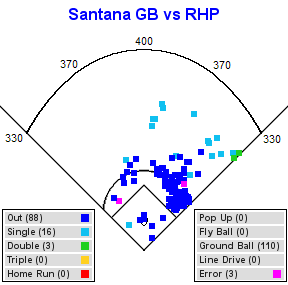Carlos Santana certainly hasn’t been a disappointment. His .377 on-base percentage in 2013 was more than adequate and his .832 OPS was the highest of his career (excluding his 46-game rookie year).
But Santana also hasn’t fully lived up to expectations, and if he gets moved to first base on a more permanent basis these numbers will simply blend in with a large number of modest power hitters who are capable of posting similar numbers from the corner infield positions.
So what can Santana do to improve?
In terms of his power performance, what you see is what you get. He’s 27 and takes an all-or-nothing approach on the vast majority of his swings. It’s unrealistic to expect a significant up-tick in his power numbers, or at least not at a sustainable rate.
But if Santana accepts the fact that he is only capable of hitting 20-25 home runs per year, and focuses on improving his contact rate, his overall performance could improve dramatically.
The most glaring weakness in Santana’s game is his performance against right-handed pitching. While his on-base percentage was equal from both sides of the plate in 2013, both his average and slugging percentage were nearly 50 points lower from the left side.
 This is partially due to Santana’s approach at the plate. He’s takes big cuts and tries to pull everything – a trend which opposing defenses have adjusted to and it’s easy to see why. In fact, according to Baseball Info Solutions, Santana was the 17th-most shifted against left-handed batter in the league (and he’s not even a full-time lefty!).
This is partially due to Santana’s approach at the plate. He’s takes big cuts and tries to pull everything – a trend which opposing defenses have adjusted to and it’s easy to see why. In fact, according to Baseball Info Solutions, Santana was the 17th-most shifted against left-handed batter in the league (and he’s not even a full-time lefty!).
Against right-handed pitching, Santana pulled 74.5 percent of his ground balls – the third highest rate in the league.
So it should come as no surprise that defenses applied the shift and essentially turned Santana into an easy out. When Santana hit the ball on the ground against righties, he posted a .173 batting average – third worst in the majors by a left-handed batter.
Santana is hardly the first lefty to struggle going the opposite way against right-handed pitching. David Ortiz, for example, has been shifted against for the majority of his career.
But Ortiz’s numbers (his .236 average is right in line with the league average) have improved as he has taken advantage of more outside pitches by slapping them into left field.
Now you may be wondering how often pitchers give Santana pitches to work with. Surely they’re pitching him inside to induce these easy ground ball outs to the right side of the infield, right?
To an extent, this is true. Santana saw the 14th lowest percentage of outside pitches as a lefty against right-handed pitching. However, it doesn’t fully explain away the issue.
The Heat Map below shows the pitch location frequency of the all the ground balls Santana hit against righties. As you can see, the vast majority came on pitches down the middle or away.
Clearly pitchers are giving Santana plenty of opportunities to beat the shift. And it wouldn’t even require a dramatic change to his approach.
Santana pulled 51.5 percent of the outside pitches he saw from right-handed pitchers, the second highest rate in the league.
Any advantage Santana could find against the shift would be an improvement, because the shift is killing him.
The simplest way to determine the impact of a shift is to compare a player’s Babip (batting average on balls in play) with men on and with the bases empty (since there will rarely be a full shift with men on base).
Against right-handed pitchers, Santana posted a .341 Babip with men on (no shift) compared to .234 with the bases empty (against the shift). His Babip with bases empty was the third lowest in the majors, and given the defensive adjustments made against him, it’s hard to chalk that up to bad luck.
To get an idea for just how abysmal those splits are for Santana, take a look at a few other frequently-shifted left-handed batters:
Chris Davis – Empty: .342, Men on: .371, Difference: -.029
Jay Bruce – Empty: .320, Men on: .359 – Difference: -.039
Adam Dunn – Empty: .246, Men on: .292, Difference: -.046
Brandon Belt – Empty: .331, Men on: .385, Difference: -.054
Santana’s numbers against the shift are so weak it’s tough to imagine hitting coach Ty Van Burkleo hasn’t already discussed an alternative approach with Santana. But hitters, especially power hitters, can be notoriously stubborn and the results certainly seem to indicate Santana is one of those.
Hopefully 2014 brings a new approach for one of the critical men in the Tribe’s lineup.




Santana is deadly when he goes the other way. So is Kipnis. They just have to learn to trust themselves to do it consistently.
thats a spot-on analysis. good work.